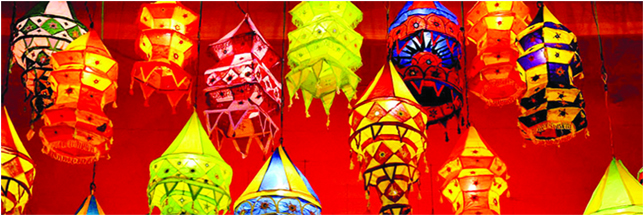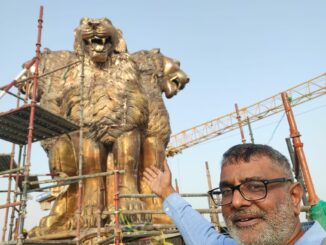
Choti Diwali or Narak Chaturdashi is generally observed a day before Badi Diwali. But this year, Chhoti Diwali and Badi Diwali will be celebrated on the same date (Monday, 24 October 2022) because the solar eclipse will be observed on the next day (25 October 2022). Choti Diwali is recognized to commemorate the triumph of Lord Krishna and his wife Satyabhama over the tyrant King Narakasura.
Choti Diwali 2022: Date, Time, and Tithi
– Choti Diwali date 2022 is Monday, 24 October 2022. According to Drik Panchang, the Choti Diwali or Narak Chaturdashi Tithi is as follows:
– Chaturdashi Tithi Starts: Sunday, 23 October 2022 at 6:03 pm.
– Chaturdashi Tithi Ends: Monday, 24 October 2022 at 5:27 pm.
– Pradosh Kaal: 5:44 pm to 8:17 pm.
– Vrishabha Kaal: 6:54 pm to 8:50 pm.
– Amavasya Tithi Starts: 24 October 2022 at 5:27 pm.
– Amavasya Tithi Ends: 25 October 2022 at 4:18 pm.
Worship of Shri Krishna
It is said that on this day Lord Krishna killed a demon named Narakasura and honored sixteen thousand and one hundred girls by freeing them from the prison house of Narakasura.
Worship of Yamraj
There is a law to get up before sunrise, after taking a bath and offer three Anjali waters to Yamraj. In the evening, lamp should be donated for Yamraj.
Choti Diwali Puja
Before sunrise, take a bath by rubbing the paste of flour, oil, turmeric. Then take a four-faced lamp and 16 small lamps in a plate and light it by putting oil wick in them. Then worship with roli, kheel, jaggery, incense, abir, gulal, flowers etc. First the men of the house then the women should worship. After the worship, keep all the lamps at every place inside the house. Keep the four-faced lamp at the main door. Put a check in front of Lakshmi and light incense.
Legends behind Choti Diwali
The story goes that the demon king Narakasur ruler of Pragjyotishpur (a province to the South of Nepal) after defeating Lord Indra had snatched away the magnificent earrings of Aditi, the Mother Goddess (the ruler of Suraloka and a relative of Satyabhama, Lord Krishna’s wife) and imprisoned sixteen thousand daughters of the gods and saints in his harem. On coming to know about this, Satyabhama was enraged by Narakasura’s malevolence towards women, and she appealed to Krishna to give her the golden chance to destroy Narakasura. The legend also says that Narakasura was given a curse that he would be killed by a woman. Krishna granted Satyabhama a boon to fight with Narakasura. With Krishna as the charioteer, Satyabhama entered the battle field. During the war, Krishna swooned for a while, a preordained divinely act adopted to empower Satyabhama to kill the demon. After Narakasura was beheaded, the imprisoned women were released, and Krishna accepted to marry them.
So on the day previous to Narakachaturdashi, Lord Krishna’s divine intervention led to the killing of the demon, Narakasura and liberation of the imprisoned damsels as well as recovery of the precious earrings of Aditi. As a symbol of that victory Lord Krishna smeared his forehead with the demon king’s blood. Krishna returned home in the very early morning of the Narakachaturdashi day. The womenfolk massaged scented oil to his body and gave him a good bath to wash away the filth from his body. Since then the custom of taking bath before sunrise on this day has become a traditional practice specially in Maharashtra.
It is interesting to note that Bhudevi, mother of the slain Narakasura, declared that his death should not be a day of mourning but an occasion to celebrate and rejoice. Since then, Deepavali is being celebrated by people every year with joyous celebrations with lot of fun and frolic, and fire works.
In South India that victory of the divine over the mundane is celebrated in a very peculiar way. People wake up before sunrise prepare a paste by mixing Kumkum in oil, symbolizing blood and after breaking a bitter fruit that represents the head of the demon King that was smashed by Krishna, apply that mixture on their foreheads. Then they have an oil bath using sandalwood paste.
In Maharashtra also, traditional early baths with oil and “Uptan” (paste) of gram flour and fragrant powders are a `must’. All through the ritual of baths, deafening sounds of crackers and fireworks are there in order that the children enjoy bathing. Afterward steamed vermicelli with milk and sugar or puffed rice with curd is served.
The Tradition of Lights
The Diwali illuminations with lighted diyas bring the supernatural brightness and joy with the hope of finding light in darkness, achieving knowledge where there is ignorance, and spreading love amidst hatred. Diwali is also known as the Festival of Lights. Light is significant in Hinduism because it signifies goodness. So, during the Festival of Lights, ‘deeps’, or oil lamps, are burned throughout the day and into the night to ward off darkness and evil.
Homes are filled with these oil lamps, candles and lights. Some people use decorated light candles, some decorated diya or clay lamps, and other decorative lights and put them in their windows for the festival. Traditionally people use ‘earthen lamps’ with cotton wicks and oil to light up the dark night. As man progresses, tradition gives way to modernity. Similarly, earthen lamps have replaced candles of various colors and forms. Electric lights of different shapes and sizes illuminate the dark, cold nights of Diwali.
The idea behind the Festival of Lights comes from various versions of an ancient Hindu story. In northern India, the tale tells about the holy Lord Rama’s return from a twelve-year exile and the celebration by the people for their beloved hero. The pious and rejoicing people decorated their city with candles and lights to welcome him back. In southern India, the story talks of the Goddess Durga’s triumph over the evil demon Narakasura. This triumph of good over evil brought back the light of knowledge and truth to mankind.
In the city, as elsewhere, Diwali celebrations have become contemporary in keeping with the changing times. Until a decade ago, most city households used to illuminate their houses with the warm, sparkling bright lights of earthen lamps. But now, in addition to these diyas, wax candles of various colours and forms and colored electric bulbs of different shapes and sizes are illuminated soon after dusk.
Those who have a fancy for different types of earthen lamps can opt for handi lamps (earthen lamps shaped as handis or bowls). Some of these handi lamps with the designer touch, with innovative designs glittering and sparkling on them, are sold by a few women from their home boutiques. Then there are also the star-shaped earthen diyas that hold a large quantity of oil and five wick in one lamp and are available at roadside stalls. Corners of rooms and puja rooms can be decorated and lighted up with brass, copper or metal lamps. Candles also offer a wide choice. There are the regular rod-shaped candles available in small, medium and large sizes at all roadside kiosks and shops. For those looking for designer candles, there are the flower-shaped and heart-shaped floating candles in soft hues. These scented candles when placed in glass bowls filled with water will float and burn for about two-and-a-half hours. Besides, the stores also has a collection of glass gel candles that burn for days together and are drip-free.
Diwali Pooja Thali Decoration Ideas
– Take a round shaped thali.
– In a little place draw the swastika sign with any colour you like
– Take one diya shaped like a goddess. Place in the front side or middle.
– Take some flowers of your choice, preferably hibiscus. Place these flowers on the thali.
– Take a agarbatti stand and light some agarbati.
– Take a small bell.
– Than take the sonkha (The big thing like seashell used for praying god). If your thali has some space left fill that with colours.
Aarti thali with bindi decoratation
– Cover ur thali by using any single colored paper.
– Stick your wasted bindi on this thali.
– Make ur favourite design on the thali by using different styles of bindis.
– Put a small dish with diya on it.
– Also stick ganpati or laksmiji picture in it. Your arti thali is ready.





Be the first to comment